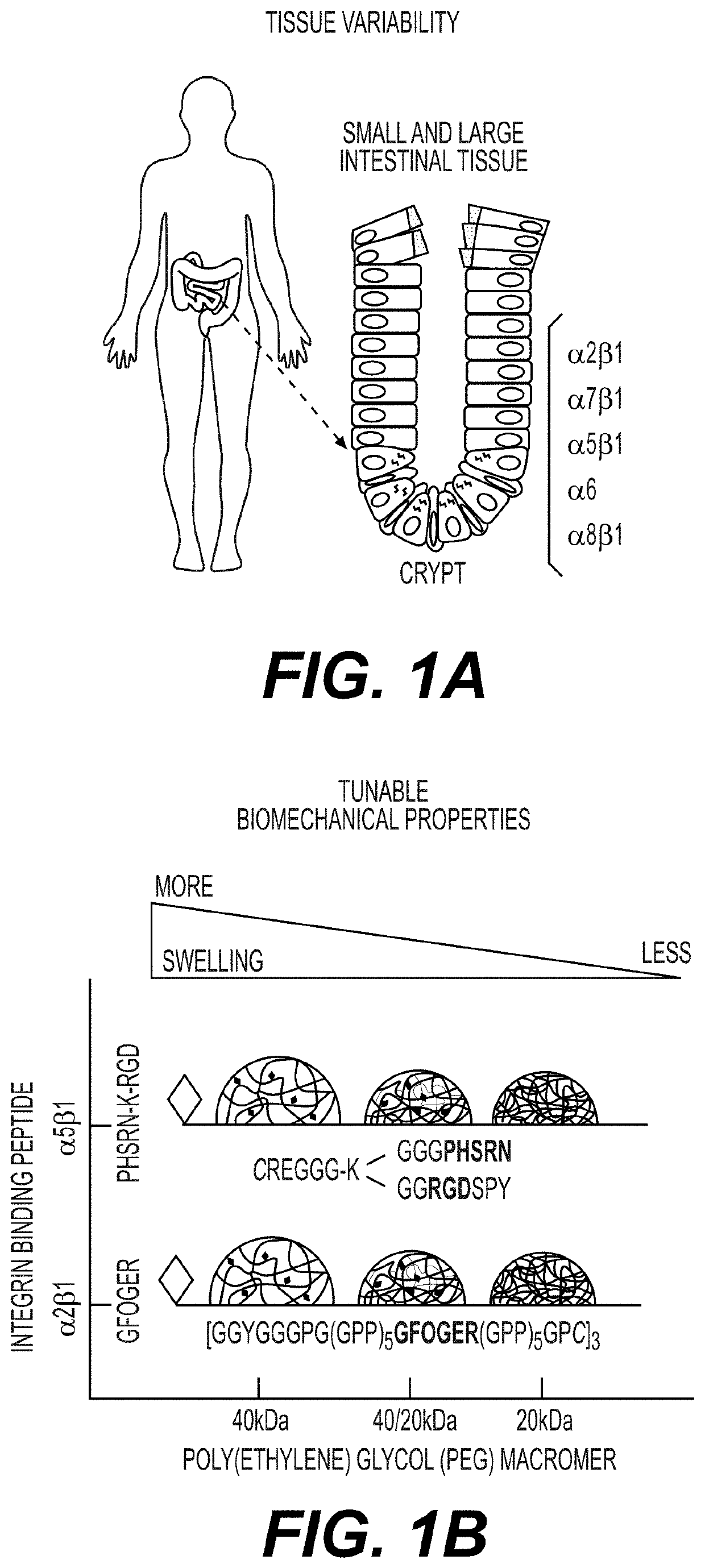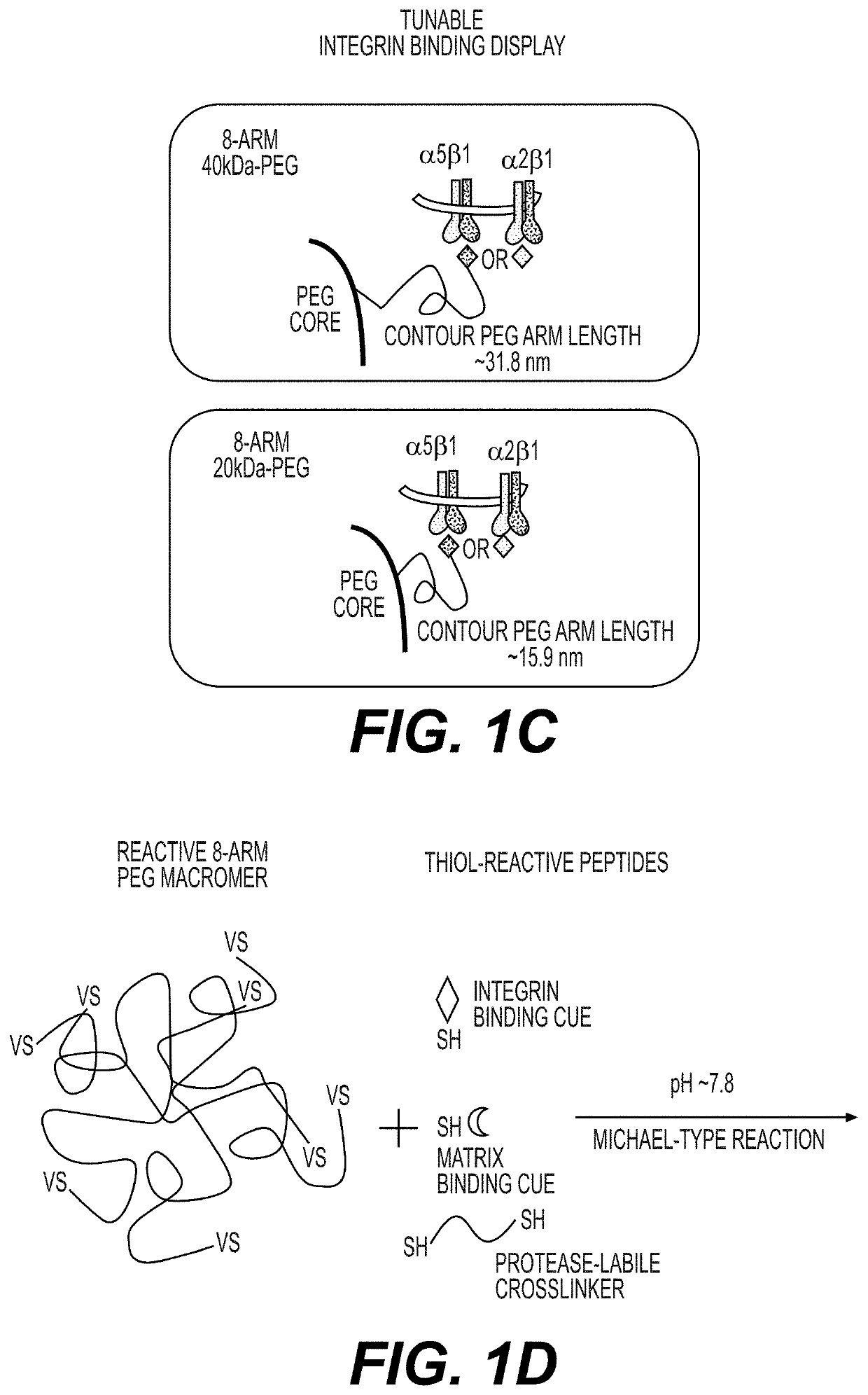Synthetic hydrogels for organogenesis
a technology of organogenesis and synthetic hydrogels, which is applied in the field of synthetic hydrogels for organogenesis, can solve problems such as inability to grow and use, and achieve the effects of improving the cell culture efficiency and reducing the production cos
- Summary
- Abstract
- Description
- Claims
- Application Information
AI Technical Summary
Benefits of technology
Problems solved by technology
Method used
Image
Examples
example 1
ation of Components for Synthetic Hydrogels
[0208]Integrin expression in tissue of origin / niche was identified. Integrin binding peptide was selected to create tunable synthetic hydrogels (FIGS. 1A-1B)
[0209]Multi-arm polyethylene glycol (PEG) polymers of various molecular weights, small peptides, and inhibitors were identified as the components formulating the synthetic hydrogels. Specifically, 20 kDa 8-arm PEG, 40 kDa 8-arm PEG, or a combination of both were identified for forming PEG hydrogels. The PEG arms were functionalized with vinyl sulfone (VS) groups.
[0210]Integrin binding peptides derived from collagen type I (containing the sequence GFOGER (SEQ ID NO:1)) and fibronectin (containing the sequence PHSRN (SEQ ID NO:2)) were selected for cell adhesion. The peptide derived from collagen type I has high affinity for integrin α2β1, α1β1, α10β1, and α11β1. The peptide derived from fibronectin has high affinity for integrin αvβ3 and moderate affinity for integrin α5β1. The integrin ...
example 2
of Synthetic Hydrogels with Tunable Biomechanical Properties
[0214]Materials and Methods
[0215]Assembly of Synthetic Hydrogels
[0216]The PEG polymer arms were functionalized with vinyl sulfone groups (purchased from JenKem Technology, Beijing). The integrin-binding peptides and extracellular protein binding peptides were synthesized to contain a free thiol group at the N-terminus. The crosslinkers are dithiols with one thiol group at each terminus. The PEG hydrogels (3.5-10%, weight / volume) were assembled via sequential Michael-type addition reactions between the vinyl sulfone groups on the PEG polymer arms and the terminal thiol groups of the integrin binding peptides (0.25-3 mM) and extracellular protein binding peptides (0.25-0.5 mM) (FIG. 1D). Cells and ROCK inhibitors were then mixed with the peptide-PEG polymer adducts. The peptide-PEG polymer adducts were crosslinked with crosslinkers (thiol of cross linker:VS, 0.35-1), such as dithiol-MMP cleavable peptides (FIG. 1D-E). The PEG...
example 3
Hydrogels Support Organoid Growth
[0223]Materials and Methods
[0224]Human intestinal stem cells were obtained from multiple donors. Cell cultures on hydrogels follow procedures previously reported (Cook, et al., Integrative Biology, 9:271-289 (2017)). Organoid growth was monitored using microscope. Human and mouse epithelial cell organoids were cultured on the hydrogels formulated according to Examples 1 and 2.
[0225]To test the response of organoids to drugs, organoids formed in synthetic hydrogels or MATRIGEL® were stimulated with prostaglandin E2 and forskolin. The diameter of organoids before and after prostaglandin stimulation was measured in images recorded by a microscope (FIG. 8D-E).
[0226]Results
[0227]Human duodenum stem cells from multiple donors form organoids in the synthetic hydrogels. Live imaging data shows that only few cells were dead by Day 6, not all stem cells form organoids, and the formed organoids varied in size. Cells that do not form organoids remain viable afte...
PUM
| Property | Measurement | Unit |
|---|---|---|
| molecular weight | aaaaa | aaaaa |
| molecular weight | aaaaa | aaaaa |
| molecular weight | aaaaa | aaaaa |
Abstract
Description
Claims
Application Information
 Login to View More
Login to View More - R&D
- Intellectual Property
- Life Sciences
- Materials
- Tech Scout
- Unparalleled Data Quality
- Higher Quality Content
- 60% Fewer Hallucinations
Browse by: Latest US Patents, China's latest patents, Technical Efficacy Thesaurus, Application Domain, Technology Topic, Popular Technical Reports.
© 2025 PatSnap. All rights reserved.Legal|Privacy policy|Modern Slavery Act Transparency Statement|Sitemap|About US| Contact US: help@patsnap.com



